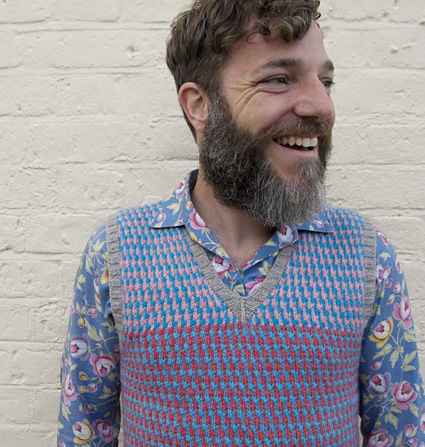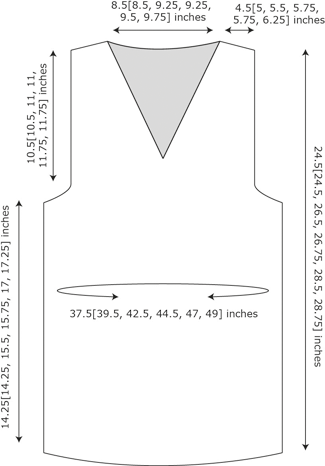

|
|
|

Aside from the diagonal lean in the colourwork, the super soft Knit by Numbers merino from John Arbon Textiles is worth leaning on too. John and Juliet are really rock and roll, so it seemed appropriate to give this vest a musical name, though I think they might prefer something a bit more punk. And finally, like the cobbler's children who don't have shoes, my honey (who is always there to lean on) hasn't had a garment knitted by me till now*. The colors were his choice and quite a surprise to me -- my tastes must be rubbing off on him! The nice thing about Knit by Numbers yarn is that there are 6 shades of each of the 13 colors, making 78 shades that are super simple to combine for colorwork. I wanted to play with the gradient and so have used the red running from light pink at the shoulders to bright red at the waist, while the blue runs in reverse, from pale blue at the bottom to a vibrant one at the shoulders. It needed a good neutral color for the ribbing, which is where the soft grey stepped in. Next time I will try it as an ombre. *It's a fact he likes to ham up for sympathy when company are present. At these times he interestingly fails to mention the number of hats and scarves I've made for him (and the number he's lost).
|
||
|
|
||
|
SIZE |
|
|
FINISHED MEASUREMENTS |
|
MATERIALS Notions |
|
GAUGE |
| 24sts/26rows = 4 inches in Lean On Me Pattern on larger needles |
|
PATTERN NOTES |
|
You want the cast-on and bind-off edgings to have stretch without being billowy. Read this for more about loosening your cast on. And here's information on loosening your bind off. Give yourself a way of remembering which hand holds which color range and stick to it! I used English political colors -- red for left wing in my left hand, blue for right wing in my right hand. This is to avoid color dominance issues.
Because of the diagonal in the colorwork pattern, to avoid having a distinct side seam, start the rnd 1st earlier (to the right) every other rnd (as you change from B2, R1 to B1, R2), so that the colorwork pattern flows seamlessly and joglessly around the body. This will in effect change where your row starts, but is well worth it for continuity of pattern. Here's a link to Tom of Holland's steek tutorial, which inspired me to use this specific approach to steeking. It is clear and easy to follow. Work all Steek Stitches with both yarns held together at the same time. All Edge Stitches are worked in R yarns, changing from MR to LR as required. It's not strictly necessary, but when I know I will k2tog them in the following rnd for the steek edge st, I skip on the purled stitches in the stitch pattern. I just think it sits flatter if you skip those When weaving in the ends after knotting your yarns, you may find it easier to thread the needle before or after you have slid it in to the floats at the back of the knitting. Work out what feels best for you, but try both. As naughty as it sounds, you actually need to split the yarn floats as you are skimming the ends through. You can work all the knots in one go and then move to sewing in the ends, or knot down one side and then sew the ends in.
|
|
|
|
DIRECTIONS Work 8[8, 8, 10, 10, 12] rnds in [k2, p2] rib. Break off MC. Begin working with BR and LB and change to larger needle size. Note: To keep the pattern seamless, growing in a gentle spiral, shift the marker and beginning of the rnd to the right by a stitch every other rnd until the steek placement rnd. Begin chart and increase as follows for chosen size: Keeping pattern correct, work a further 48[48, 52, 52, 56, 56] rnds -- work measures approximately 8.5[8.5, 9.25, 9.5, 10.25, 10.5] inches from cast-on edge. Break off BR and LB, join in MR and MB and continue in pattern for a further 36[36, 40, 40, 44, 44] rnds. ARMHOLE STEEKS Maintain all armhole steeks as indicated (see Pattern Notes) and all edge stitches in R (MR or LR as they change), up to the shoulders -- they will be used as the active decrease stitch to keep the pattern consistent and unaffected by the decreasing. Next rnd: Work 5 armhole steek sts correctly. Place marker for new beg of rnd. Work 1 rnd even in pattern. Armhole Dec Rnd: [Work armhole steek, ssk, work in patt up to 2 sts before next armhole steek, k2tog] twice, work to end of rnd marker. 4 sts dec'd Rep Armhole Dec Rnd 3 more times. 217[229, 239, 251, 258, 270] sts Next rnd: [Work 1 rnd even, work 1 Armhole Dec Rnd] 4 times. 201[213, 223, 235, 242, 254] sts Keeping pattern correct, work even with MR & MB until 48[48, 52, 52, 56, 56] rnds have been worked -- work measures approximately 16[16, 17.25, 17.5, 18.75, 19] inches from cast-on edge. Break off MR and MB, join in BB and LR; maintain steek and edge sts correctly as indicated. NECK STEEK Maintain all armhole and neck steeks as indicated (see Pattern Notes) and all edge stitches in R (MR or LR as they change), up to the shoulders; they will be used as the active decrease stitch to keep the pattern consistent and unaffected by the decreasing. Neck Shaping Rnd: Work armhole steek, work edge stitch, work in patt up to 2 sts before neck steek, k2tog, work neck steek, ssk, work in patt to end of rnd. 2 sts dec'd Rep Neck Shaping Rnd 4 more times. 200[212, 222, 234, 241, 253] sts Next 10 rnds: [Work 1 rnd even, work Neck Shaping Rnd] 5 times. 190[202, 212, 224, 231, 243] sts SIZES L, 1X, 2X ONLY: Stitches between steeks: 27[30, 32, 33, 35, 38] on each Front, 90[96, 102, 108, 111, 117] on Back. 3 steek sections of 10 sts each. Continue working even in pattern with LR & BB until 56[56, 60, 60, 64, 64] rnds have been worked Next rnd: Work armhole steek sts, place on hold. Work Left Front. Work neck steek sts, place on hold. Work Right Front. Work armhole steek sts, place on hold. Turn work inside out so WS is facing. Turn garment RS out. Steek: Unravel steek stitches, up to, but not including the edge stitch; knot together the 2 colors from each row of colorwork, fastening the knot as close to the steek edge stitch as you can. Weave in the ends after knotting approximately 1 inch (see Pattern Notes) then trim, leaving a small tail.
ARMHOLE EDGING Work 6 rnds of [k2, p2] rib. Bind off in pattern. NECK EDGING Dec Rnd: [K2, p2] to 1 st before centre st, CDD, work in rib to end. 2 sts dec'd Note: To ensure ribbing matches exactly, the first stitch after the CDD should be the same type and count as the stitch before the CDD (ie, if the pattern ended in k1 before the decrease was performed, begin with a k1, and apply the same logic for all following rnds) Rep Dec Rnd 5 more times. |
 |
|
FINISHING Block to size. |
| ABOUT THE DESIGNER |
|
Anna is a Londoner and ex arts school kid (with a conceptual craft leaning). She likes people watching, even if they aren't wearing knitwear. She regularly contributes to Pompom Quarterly and cofounded Ricefield Collective with friends. |
|
Pattern & images © 2014 Anna Maltz. Contact Anna |